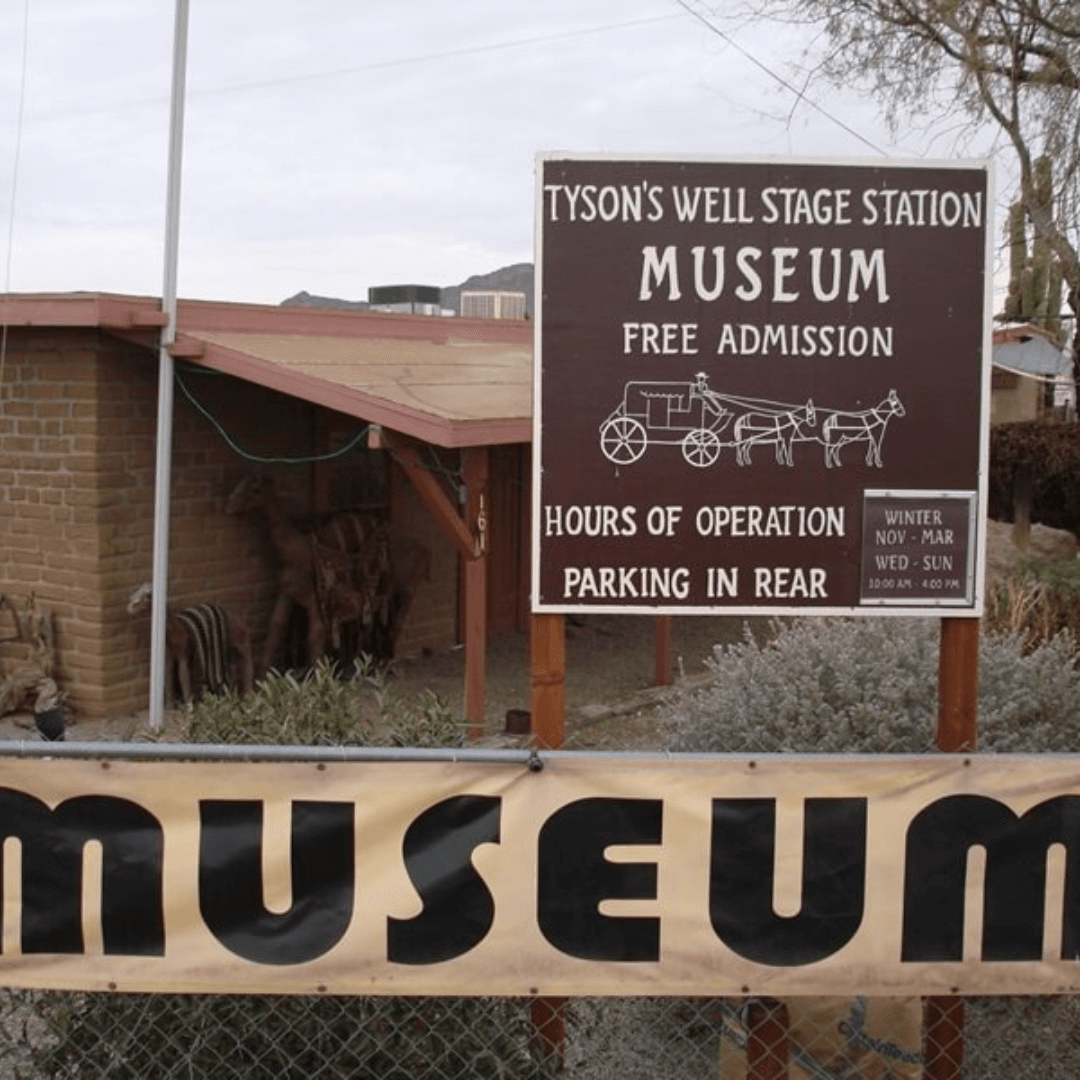Coming into the town of Quartzsite from both Interstate10 exits (Exit 19 and 17), the visitor is welcomed by recently erected artistic town signs that offer a glimpse of the town’s history. The pyramid and camels have become iconic symbols for the town, reflecting the story of a camel driver that brought camels to the American desert.
I have been fascinated with this story, and this past year we visited one more time the Tyson’s Well Stage Station Museum and spent some time collecting more historical information. We have been going to Quartzsite for the gem shows since 1997, yet the first time we visited the museum wasn’t until 2013. The winter visitors, or “snowbirds,” as they’re referred to by the locals, stay several months in the area and have more time to visit area attractions. But for many of us visiting Quartzsite only during the gem show, time is limited, and sadly, we often don’t find the time to appreciate all the town has to offer.
The Tyson’s Well Stage Station Museum, also known as the Quartzsite Museum, is located in the heart of Quartzsite, at 161 Main Street, very close to the QIA Pow-Wow show. If you want to learn more about Arizona’s early gold mining history, and how gold’s $35.00 fixed price per ounce after WWII made many of the mines unprofitable, then head over to this museum.
The Tyson’s Well Stage Station Museum is housed in the original adobe stagecoach station built in 1866 by Charles Tyson at the present location. The station served as an important watering stop for the stagecoaches and freighters carrying mining equipment and supplies to the mines and the army from the river port at Ehrenberg on the Colorado River. Miners came up the Colorado River in steamboats and either stayed in Arizona or crossed over into California heading to the gold fields.
The Station even hosted the post office from 1893 until 1895. For several years it was the town’s grocery store, lodging and food source for the local saloons. Around 1900 it became the Oasis Hotel, but over the years it got neglected, until 1972, when the Rice family donated the lot with the Stage Station for a museum to be built. The building was extensively restored, and the museum opened in 1980. It is operated by the Quartzsite Historical Society, and the wonderful volunteers are eager to share their knowledge.
Although Quartzsite itself was not a mining town, it was surrounded by many mining camps. In search of placer gold, hundreds of individual prospectors swamped the areas around Quartzsite in the 1860s and on. Water was a precious commodity, and was being hauled and delivered to the mines for a hefty price at $1.00 to $5.00 per barrel. Miners prospected mostly for gold, but also for silver, kyanite, copper and lead. The 1864 census, the first one in the territory of Arizona, showed one out of every four residents being a miner or prospector.
A wealth of information is available at a new exhibit about all the mines of the area. The Cinnaber Mine, ten miles south of Quartzsite produced quicksilver ore, valuable because gold and silver would adhere to it. The Copper Bottom Mine was ten miles southwest of Quartzsite in the Cunningham Mountains. The Ferrar Gulch Mine, ten miles west of Quartzsite, allegedly was one of the richest placer gold mines. One nugget found there weighed 47.5 pounds! Over $4 million in metal was dug out from the King of Arizona Mine (KOFA), operating from 1896-1910. The mine was so rich, that the mill had to be stopped every few hours to remove the gold from the plates.
More photos and information are exhibited about the Goodenough Mine, Mariquita, Moon Mountain, Gold Nugget mines, Bonanza Mine, Castle Dome Mining District, and the Cienega District. An area map of historical mines shows 29 mines around Quartzsite! The extensive photographic record of the mines draws the visitor into the area’s history of sweat, tears, and successful mining of gold, lead and mercury.
The fixed price for gold at $35.00 per ounce was the beginning of the end for the U.S. gold mines, until 1975 when the gold price was released, although for many years the gold prices would wildly fluctuate. Today placer gold prospecting still takes place around Quartzsite using metal detecting, dry washing, panning and sluicing. Caution is always advised. Ask at the museum or the Chamber of Commerce for information.
We were truly impressed with this little museum brimming with mining history, with the quality of the displays and the treasure-trove of information on the old mining camps. There is a great display of mining equipment inside and outside the museum, among them the Assay Office from the Mariquita Mine, containing assay and mining equipment from local mines.
Photographic portraits of Quartzsite’s famous citizens are also on display. I particularly liked the early photo of “Hi-Jolly” and his bride, as well as the humorous print of the “Rules of Stagecoach Etiquette,” that gives a glimpse of what stagecoach passengers could or could not do, regarding smoking, chewing tobacco, spitting, abstinence from liquor, rough language and firearms.
In the museum’s yard, there is a fabulous display labeled “Barretts’ Miniature Village.” It was created by Walter Barrett, a long-time winter resident of Quartzsite. The stone house buildings are replicas of buildings from his past, and Barrett spent eight years building them. The village was donated by Barrett’s children to the Historical Society after his death.
The museum has a small gift shop and bookstore. Among the books available is Lost Mines and Prospector’s Lore adapted from the diaries of a local miner and artist, Bill Keiser, a fascinating read for those interested in mining history. Also available is Stone Cabins by Carol Nilson, with information about old mine sites and stone cabins that dot the desert areas around Quartzsite. Another great two-volume book available at the museum is Gold Atlas of Quartzsite, by Dr. Erik Melchiorre.
There is no admission fee to the Tyson’s Well Stage Station Museum, although donations are always appreciated. Please visit the museum’s website for hours and more info at www.quartzsitemuseum.com.
The Camel expedition story
So, how did the camels of the Middle East deserts become iconic symbols of the Arizona deserts? It all started with the idea to bring hardy camels from the deserts of the Middle East to the American West to help the army carry their supplies more easily through the tough desert terrain. A camel could carry about 600 pounds for up to thirty miles per day, much better than the mules, and travel longer without water. The idea was hatched in 1836, in Florida, by Major George H. Crossman, who then relayed it to Major Henry C. Wayne. Twelve years later Wayne mentioned the idea to Jefferson Davis, who at the time was a senator from Mississippi, and later secretary of war and president of the Confederate States of America.
In 1857, a 35-year old retired Navy lieutenant named Edward Fitzgerald Beale was in charge of establishing new wagon and railroad routes westward to California. The army sent some military men to the Middle East, who sent 33 camels from Tunisia, Egypt and Smyrna (in Turkey) in 1856, and another 44 camels the following year, to Galveston, Texas. Beale, in charge of the camel expedition, hired a lead camel driver named Philip Tedro, known as Hadji Ali, to take care of the camels.
Hadji Ali was born in Smyrna circa 1828 to a Greek mother and a Syrian father, who was a Christian Arab. Tedro converted to Islam as a young adult and went to Mecca to perform the rites of Hajj. As an Ottoman Turkish citizen he worked as a camel breeder and trainer in Syria, and had joined the French Army in Algiers before joining the U.S. Army.
More camel drivers, referred to at the time as “Turkmen” or “Orientals,” eight of them of Greek origin, were also employed for Beale’s expedition from New Mexico to California, with the notion that the camels would respond to the Arabic language. Even Beale himself rode a camel. Although Beale thought that the camels were serving the army well, others did not agree because they found them to be ill-tempered and smelly. Also, the fellow Army pack animals — burros, horses and mules — did not get along with the camels and were often panicked by their large size.
The camel experiment was forgotten once the Civil War started in 1861. When the Civil War came to a close in 1864 the camels were officially discharged and sold. Thirty-four camels were auctioned off in 1864 at Benicia, Calif., and the remaining 66 at Camp Verde, Tex., in 1866. Some went to zoos, others to circuses and some were turned loose in the desert.
Hadji Ali (or “Hi Jolly” by his anglicized nickname) acquired two camels and joined the freighting business from the Colorado River ports to the mining camps. Then, in 1868, he released the camels near Gila Bend and became a prospector. He wandered through the Mohave Desert in California and the western Arizona deserts around today’s Quartzsite. In 1880 he married Gertudis Serna, a Tucson woman. They had two children, and Ali reverted to his original name, Philip Tedro. He moved to Quartzsite by himself in his final years and served as an Army scout on and off for thirty years. He never received a pension from the Army and died penniless in 1902 at the age of 75. He is buried in Quartzsite, in the middle of town.
A unique stone pyramid monument with a copper camel on top marks Hadji Ali’s gravesite. In 1935, the Hi Jolly Monument was dedicated by the governor of Arizona, Benjamin Moeur, to Ali and the Camel Corps. It is considered the centerpiece of the cemetery and has been placed on the National Register of Historic Places.
Hadji Ali’s story and the camel experiment were featured in the 1954 movie Southwest Passage and the 1976 movie Hawmps! (www.en.wikipedia.org/wiki/Hi_Jolly)




